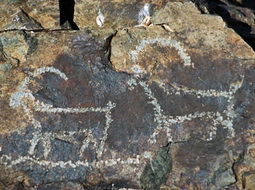Petroglyphs of Beldersay
Petroglyph (petroglyph, from Greek πέτρα – stone, γλφφω – cut) means writing on stone, representing images carved on a rocky surface. They belong to the Paleo-, Meso- and Neolithic periods and are found everywhere (except Antarctica) as a prehistoric monument of the culture and life of ancient peoples. The similarity and stylistics of petroglyphs from different continents are surprising.
Petroglyphs of Uzbekistan are extensively represented in the mountainous regions of Uzbekistan: Nuratinsky (Sarmishsay gorge is the significant collection of petroglyphs), Zarafshan, Turkestan, and Alai ranges, in the western part of the Tien Shan. In the northwestern part of Uzbekistan, they are found in the mountains of Bukantau, Tamdytau, Sultan-Uwais, and Kuldzhuktau in the south - they are located on the Kugitang ridge. Mountains and caves with rock paintings are found even among the sands of the boundless Kyzylkum desert!
You can find about 150 archaeological sites in Uzbekistan with approximate dating - the 10th millennium BC. Some of them have been investigated and are under the protection of the state, and others are influenced by natural and anthropogenic factors, irretrievably losing part of historical information.
Near Tashkent, not far from the recreation areas of Chimgan and Beldersay, in the mountain upper reaches (2450 m), there is a monument of rock art of the prehistoric era - the petroglyphs of Beldersay (or Kumbel petroglyphs). To get to them, you will have to overcome the ascent to the Chet Kumbel pass. Here, in the works of parietal art, the first attempts to rethink essential components of life by ancient people living on the territory of Uzbekistan are captured. The plot compositions reflect hunting as the basis of survival, fishing, the improvement of tools, and the domestication of animals.
Beldersay petroglyphs still hold more mysteries than they give answers therefore they are of great interest to researchers. The Kumbel petroglyphs are hard to study due to the natural conditions themselves – the height becomes an obstacle for specialists unprepared for such loads, making conservation impossible. The sun, winds, and water in the composition of snow masses have been smoothing the relief and washing out the pigment for thousands of years. Combined with the lack of additional artifacts, it is difficult to identify them. To date, only the fact that their minimum age dates back to 6000 years is reliably known.
Tours to the petroglyphs of Uzbekistan are a thematic program for archaeologists. But they can also add a bright excursion and educational component to the route for climbers, trekkers, and tourists. Beldersay Valley is the attraction where the past and the present meet, rushing into the future. The stone giants stretched up, lost in the shroud of clouds, seem to be consonant with eternity. Come here to feel part of the never-ending history of the world.
 |
 |
 |
 |









